Ethical Dilemmas in Nursing Practice: Case Studies and Solutions
VerifiedAdded on 2022/08/20
|7
|1811
|21
Essay
AI Summary
This essay explores ethical dilemmas encountered in nursing practice through three case studies. The first case involves a patient, Alan, who threatens self-harm, raising questions about respecting patient autonomy versus ensuring patient safety. The second case presents a situation where a patient, Mary, is suspected of abuse, and the nurse must decide whether to report the incident. The third case concerns breaking bad news to a cancer patient. The essay discusses relevant ethical principles such as beneficence, non-maleficence, and informed consent, as well as the application of the Mental Capacity Act and the NMC code. The analysis includes good and bad practices, and the legal implications of restraint. References are provided to support the arguments presented.
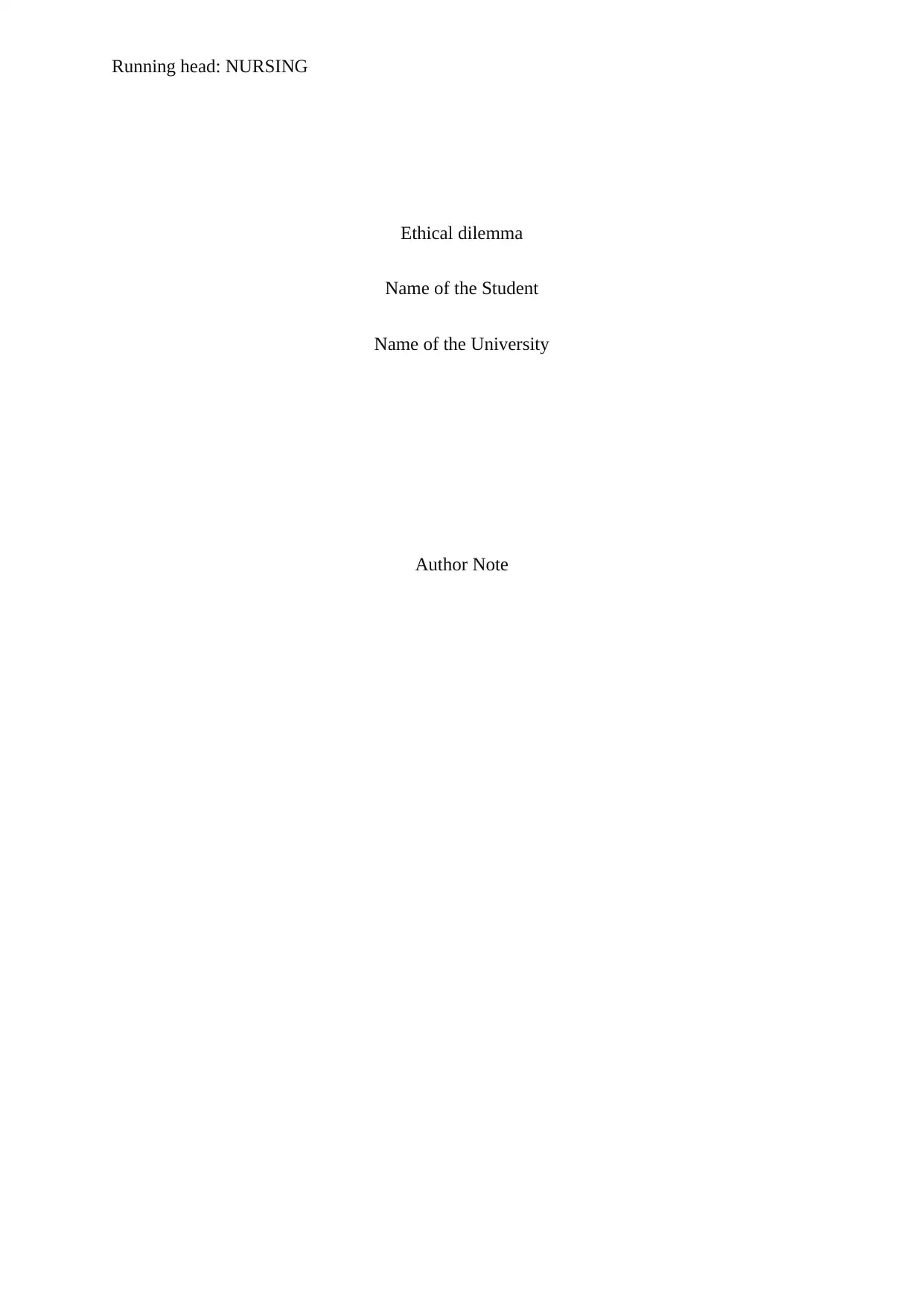
Running head: NURSING
Ethical dilemma
Name of the Student
Name of the University
Author Note
Ethical dilemma
Name of the Student
Name of the University
Author Note
Paraphrase This Document
Need a fresh take? Get an instant paraphrase of this document with our AI Paraphraser
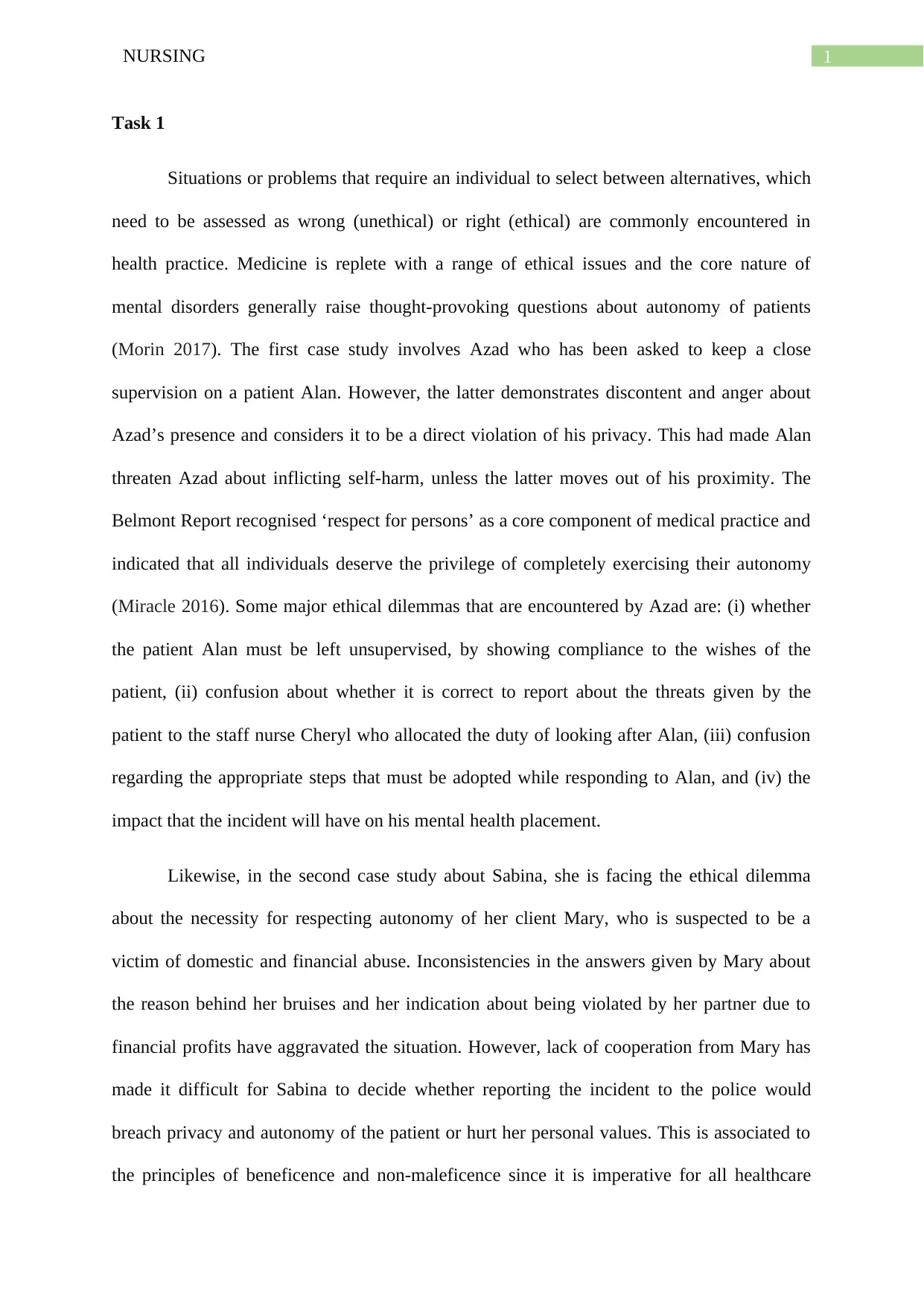
1NURSING
Task 1
Situations or problems that require an individual to select between alternatives, which
need to be assessed as wrong (unethical) or right (ethical) are commonly encountered in
health practice. Medicine is replete with a range of ethical issues and the core nature of
mental disorders generally raise thought-provoking questions about autonomy of patients
(Morin 2017). The first case study involves Azad who has been asked to keep a close
supervision on a patient Alan. However, the latter demonstrates discontent and anger about
Azad’s presence and considers it to be a direct violation of his privacy. This had made Alan
threaten Azad about inflicting self-harm, unless the latter moves out of his proximity. The
Belmont Report recognised ‘respect for persons’ as a core component of medical practice and
indicated that all individuals deserve the privilege of completely exercising their autonomy
(Miracle 2016). Some major ethical dilemmas that are encountered by Azad are: (i) whether
the patient Alan must be left unsupervised, by showing compliance to the wishes of the
patient, (ii) confusion about whether it is correct to report about the threats given by the
patient to the staff nurse Cheryl who allocated the duty of looking after Alan, (iii) confusion
regarding the appropriate steps that must be adopted while responding to Alan, and (iv) the
impact that the incident will have on his mental health placement.
Likewise, in the second case study about Sabina, she is facing the ethical dilemma
about the necessity for respecting autonomy of her client Mary, who is suspected to be a
victim of domestic and financial abuse. Inconsistencies in the answers given by Mary about
the reason behind her bruises and her indication about being violated by her partner due to
financial profits have aggravated the situation. However, lack of cooperation from Mary has
made it difficult for Sabina to decide whether reporting the incident to the police would
breach privacy and autonomy of the patient or hurt her personal values. This is associated to
the principles of beneficence and non-maleficence since it is imperative for all healthcare
Task 1
Situations or problems that require an individual to select between alternatives, which
need to be assessed as wrong (unethical) or right (ethical) are commonly encountered in
health practice. Medicine is replete with a range of ethical issues and the core nature of
mental disorders generally raise thought-provoking questions about autonomy of patients
(Morin 2017). The first case study involves Azad who has been asked to keep a close
supervision on a patient Alan. However, the latter demonstrates discontent and anger about
Azad’s presence and considers it to be a direct violation of his privacy. This had made Alan
threaten Azad about inflicting self-harm, unless the latter moves out of his proximity. The
Belmont Report recognised ‘respect for persons’ as a core component of medical practice and
indicated that all individuals deserve the privilege of completely exercising their autonomy
(Miracle 2016). Some major ethical dilemmas that are encountered by Azad are: (i) whether
the patient Alan must be left unsupervised, by showing compliance to the wishes of the
patient, (ii) confusion about whether it is correct to report about the threats given by the
patient to the staff nurse Cheryl who allocated the duty of looking after Alan, (iii) confusion
regarding the appropriate steps that must be adopted while responding to Alan, and (iv) the
impact that the incident will have on his mental health placement.
Likewise, in the second case study about Sabina, she is facing the ethical dilemma
about the necessity for respecting autonomy of her client Mary, who is suspected to be a
victim of domestic and financial abuse. Inconsistencies in the answers given by Mary about
the reason behind her bruises and her indication about being violated by her partner due to
financial profits have aggravated the situation. However, lack of cooperation from Mary has
made it difficult for Sabina to decide whether reporting the incident to the police would
breach privacy and autonomy of the patient or hurt her personal values. This is associated to
the principles of beneficence and non-maleficence since it is imperative for all healthcare
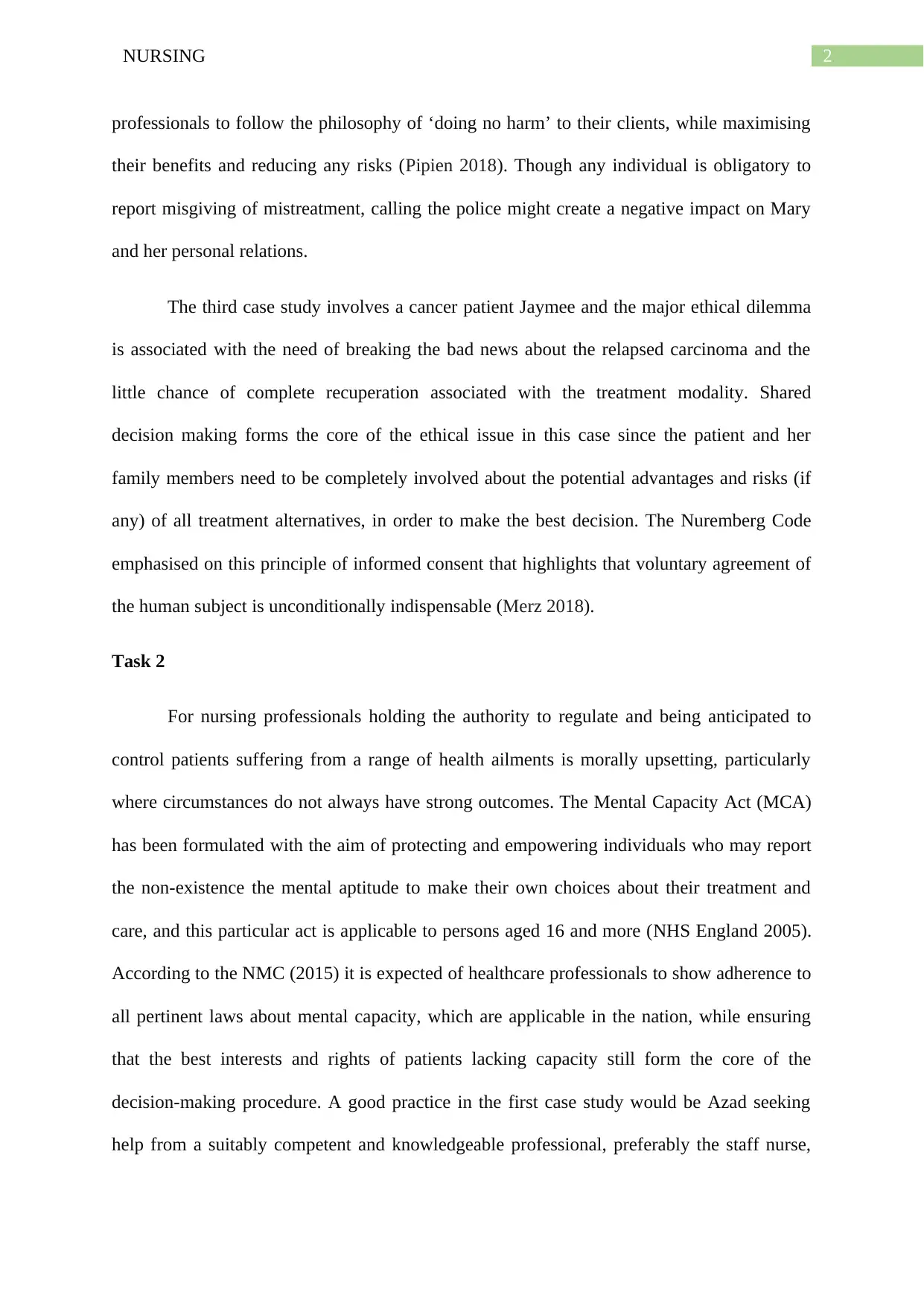
2NURSING
professionals to follow the philosophy of ‘doing no harm’ to their clients, while maximising
their benefits and reducing any risks (Pipien 2018). Though any individual is obligatory to
report misgiving of mistreatment, calling the police might create a negative impact on Mary
and her personal relations.
The third case study involves a cancer patient Jaymee and the major ethical dilemma
is associated with the need of breaking the bad news about the relapsed carcinoma and the
little chance of complete recuperation associated with the treatment modality. Shared
decision making forms the core of the ethical issue in this case since the patient and her
family members need to be completely involved about the potential advantages and risks (if
any) of all treatment alternatives, in order to make the best decision. The Nuremberg Code
emphasised on this principle of informed consent that highlights that voluntary agreement of
the human subject is unconditionally indispensable (Merz 2018).
Task 2
For nursing professionals holding the authority to regulate and being anticipated to
control patients suffering from a range of health ailments is morally upsetting, particularly
where circumstances do not always have strong outcomes. The Mental Capacity Act (MCA)
has been formulated with the aim of protecting and empowering individuals who may report
the non-existence the mental aptitude to make their own choices about their treatment and
care, and this particular act is applicable to persons aged 16 and more (NHS England 2005).
According to the NMC (2015) it is expected of healthcare professionals to show adherence to
all pertinent laws about mental capacity, which are applicable in the nation, while ensuring
that the best interests and rights of patients lacking capacity still form the core of the
decision-making procedure. A good practice in the first case study would be Azad seeking
help from a suitably competent and knowledgeable professional, preferably the staff nurse,
professionals to follow the philosophy of ‘doing no harm’ to their clients, while maximising
their benefits and reducing any risks (Pipien 2018). Though any individual is obligatory to
report misgiving of mistreatment, calling the police might create a negative impact on Mary
and her personal relations.
The third case study involves a cancer patient Jaymee and the major ethical dilemma
is associated with the need of breaking the bad news about the relapsed carcinoma and the
little chance of complete recuperation associated with the treatment modality. Shared
decision making forms the core of the ethical issue in this case since the patient and her
family members need to be completely involved about the potential advantages and risks (if
any) of all treatment alternatives, in order to make the best decision. The Nuremberg Code
emphasised on this principle of informed consent that highlights that voluntary agreement of
the human subject is unconditionally indispensable (Merz 2018).
Task 2
For nursing professionals holding the authority to regulate and being anticipated to
control patients suffering from a range of health ailments is morally upsetting, particularly
where circumstances do not always have strong outcomes. The Mental Capacity Act (MCA)
has been formulated with the aim of protecting and empowering individuals who may report
the non-existence the mental aptitude to make their own choices about their treatment and
care, and this particular act is applicable to persons aged 16 and more (NHS England 2005).
According to the NMC (2015) it is expected of healthcare professionals to show adherence to
all pertinent laws about mental capacity, which are applicable in the nation, while ensuring
that the best interests and rights of patients lacking capacity still form the core of the
decision-making procedure. A good practice in the first case study would be Azad seeking
help from a suitably competent and knowledgeable professional, preferably the staff nurse,
⊘ This is a preview!⊘
Do you want full access?
Subscribe today to unlock all pages.

Trusted by 1+ million students worldwide
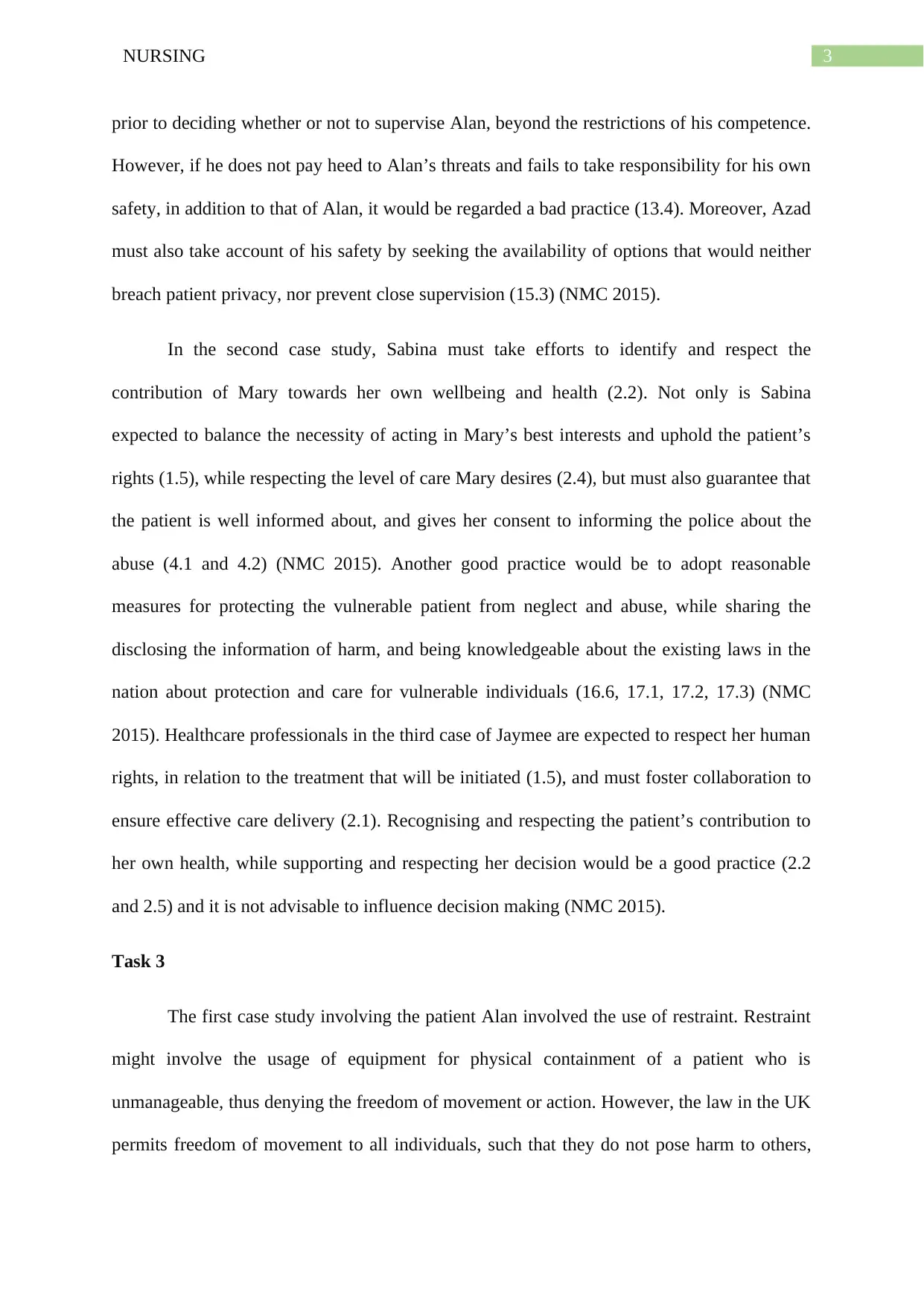
3NURSING
prior to deciding whether or not to supervise Alan, beyond the restrictions of his competence.
However, if he does not pay heed to Alan’s threats and fails to take responsibility for his own
safety, in addition to that of Alan, it would be regarded a bad practice (13.4). Moreover, Azad
must also take account of his safety by seeking the availability of options that would neither
breach patient privacy, nor prevent close supervision (15.3) (NMC 2015).
In the second case study, Sabina must take efforts to identify and respect the
contribution of Mary towards her own wellbeing and health (2.2). Not only is Sabina
expected to balance the necessity of acting in Mary’s best interests and uphold the patient’s
rights (1.5), while respecting the level of care Mary desires (2.4), but must also guarantee that
the patient is well informed about, and gives her consent to informing the police about the
abuse (4.1 and 4.2) (NMC 2015). Another good practice would be to adopt reasonable
measures for protecting the vulnerable patient from neglect and abuse, while sharing the
disclosing the information of harm, and being knowledgeable about the existing laws in the
nation about protection and care for vulnerable individuals (16.6, 17.1, 17.2, 17.3) (NMC
2015). Healthcare professionals in the third case of Jaymee are expected to respect her human
rights, in relation to the treatment that will be initiated (1.5), and must foster collaboration to
ensure effective care delivery (2.1). Recognising and respecting the patient’s contribution to
her own health, while supporting and respecting her decision would be a good practice (2.2
and 2.5) and it is not advisable to influence decision making (NMC 2015).
Task 3
The first case study involving the patient Alan involved the use of restraint. Restraint
might involve the usage of equipment for physical containment of a patient who is
unmanageable, thus denying the freedom of movement or action. However, the law in the UK
permits freedom of movement to all individuals, such that they do not pose harm to others,
prior to deciding whether or not to supervise Alan, beyond the restrictions of his competence.
However, if he does not pay heed to Alan’s threats and fails to take responsibility for his own
safety, in addition to that of Alan, it would be regarded a bad practice (13.4). Moreover, Azad
must also take account of his safety by seeking the availability of options that would neither
breach patient privacy, nor prevent close supervision (15.3) (NMC 2015).
In the second case study, Sabina must take efforts to identify and respect the
contribution of Mary towards her own wellbeing and health (2.2). Not only is Sabina
expected to balance the necessity of acting in Mary’s best interests and uphold the patient’s
rights (1.5), while respecting the level of care Mary desires (2.4), but must also guarantee that
the patient is well informed about, and gives her consent to informing the police about the
abuse (4.1 and 4.2) (NMC 2015). Another good practice would be to adopt reasonable
measures for protecting the vulnerable patient from neglect and abuse, while sharing the
disclosing the information of harm, and being knowledgeable about the existing laws in the
nation about protection and care for vulnerable individuals (16.6, 17.1, 17.2, 17.3) (NMC
2015). Healthcare professionals in the third case of Jaymee are expected to respect her human
rights, in relation to the treatment that will be initiated (1.5), and must foster collaboration to
ensure effective care delivery (2.1). Recognising and respecting the patient’s contribution to
her own health, while supporting and respecting her decision would be a good practice (2.2
and 2.5) and it is not advisable to influence decision making (NMC 2015).
Task 3
The first case study involving the patient Alan involved the use of restraint. Restraint
might involve the usage of equipment for physical containment of a patient who is
unmanageable, thus denying the freedom of movement or action. However, the law in the UK
permits freedom of movement to all individuals, such that they do not pose harm to others,
Paraphrase This Document
Need a fresh take? Get an instant paraphrase of this document with our AI Paraphraser
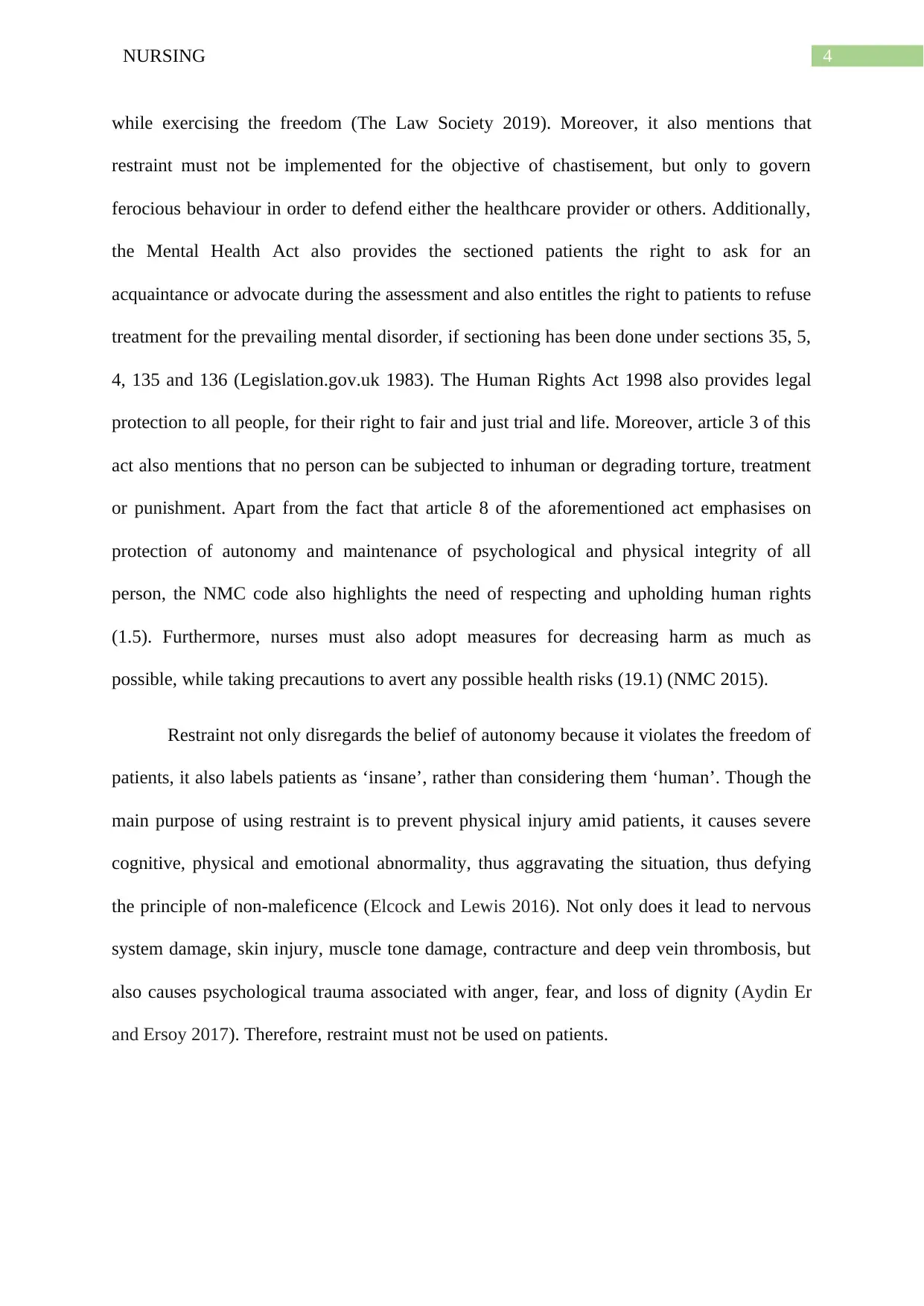
4NURSING
while exercising the freedom (The Law Society 2019). Moreover, it also mentions that
restraint must not be implemented for the objective of chastisement, but only to govern
ferocious behaviour in order to defend either the healthcare provider or others. Additionally,
the Mental Health Act also provides the sectioned patients the right to ask for an
acquaintance or advocate during the assessment and also entitles the right to patients to refuse
treatment for the prevailing mental disorder, if sectioning has been done under sections 35, 5,
4, 135 and 136 (Legislation.gov.uk 1983). The Human Rights Act 1998 also provides legal
protection to all people, for their right to fair and just trial and life. Moreover, article 3 of this
act also mentions that no person can be subjected to inhuman or degrading torture, treatment
or punishment. Apart from the fact that article 8 of the aforementioned act emphasises on
protection of autonomy and maintenance of psychological and physical integrity of all
person, the NMC code also highlights the need of respecting and upholding human rights
(1.5). Furthermore, nurses must also adopt measures for decreasing harm as much as
possible, while taking precautions to avert any possible health risks (19.1) (NMC 2015).
Restraint not only disregards the belief of autonomy because it violates the freedom of
patients, it also labels patients as ‘insane’, rather than considering them ‘human’. Though the
main purpose of using restraint is to prevent physical injury amid patients, it causes severe
cognitive, physical and emotional abnormality, thus aggravating the situation, thus defying
the principle of non-maleficence (Elcock and Lewis 2016). Not only does it lead to nervous
system damage, skin injury, muscle tone damage, contracture and deep vein thrombosis, but
also causes psychological trauma associated with anger, fear, and loss of dignity (Aydin Er
and Ersoy 2017). Therefore, restraint must not be used on patients.
while exercising the freedom (The Law Society 2019). Moreover, it also mentions that
restraint must not be implemented for the objective of chastisement, but only to govern
ferocious behaviour in order to defend either the healthcare provider or others. Additionally,
the Mental Health Act also provides the sectioned patients the right to ask for an
acquaintance or advocate during the assessment and also entitles the right to patients to refuse
treatment for the prevailing mental disorder, if sectioning has been done under sections 35, 5,
4, 135 and 136 (Legislation.gov.uk 1983). The Human Rights Act 1998 also provides legal
protection to all people, for their right to fair and just trial and life. Moreover, article 3 of this
act also mentions that no person can be subjected to inhuman or degrading torture, treatment
or punishment. Apart from the fact that article 8 of the aforementioned act emphasises on
protection of autonomy and maintenance of psychological and physical integrity of all
person, the NMC code also highlights the need of respecting and upholding human rights
(1.5). Furthermore, nurses must also adopt measures for decreasing harm as much as
possible, while taking precautions to avert any possible health risks (19.1) (NMC 2015).
Restraint not only disregards the belief of autonomy because it violates the freedom of
patients, it also labels patients as ‘insane’, rather than considering them ‘human’. Though the
main purpose of using restraint is to prevent physical injury amid patients, it causes severe
cognitive, physical and emotional abnormality, thus aggravating the situation, thus defying
the principle of non-maleficence (Elcock and Lewis 2016). Not only does it lead to nervous
system damage, skin injury, muscle tone damage, contracture and deep vein thrombosis, but
also causes psychological trauma associated with anger, fear, and loss of dignity (Aydin Er
and Ersoy 2017). Therefore, restraint must not be used on patients.
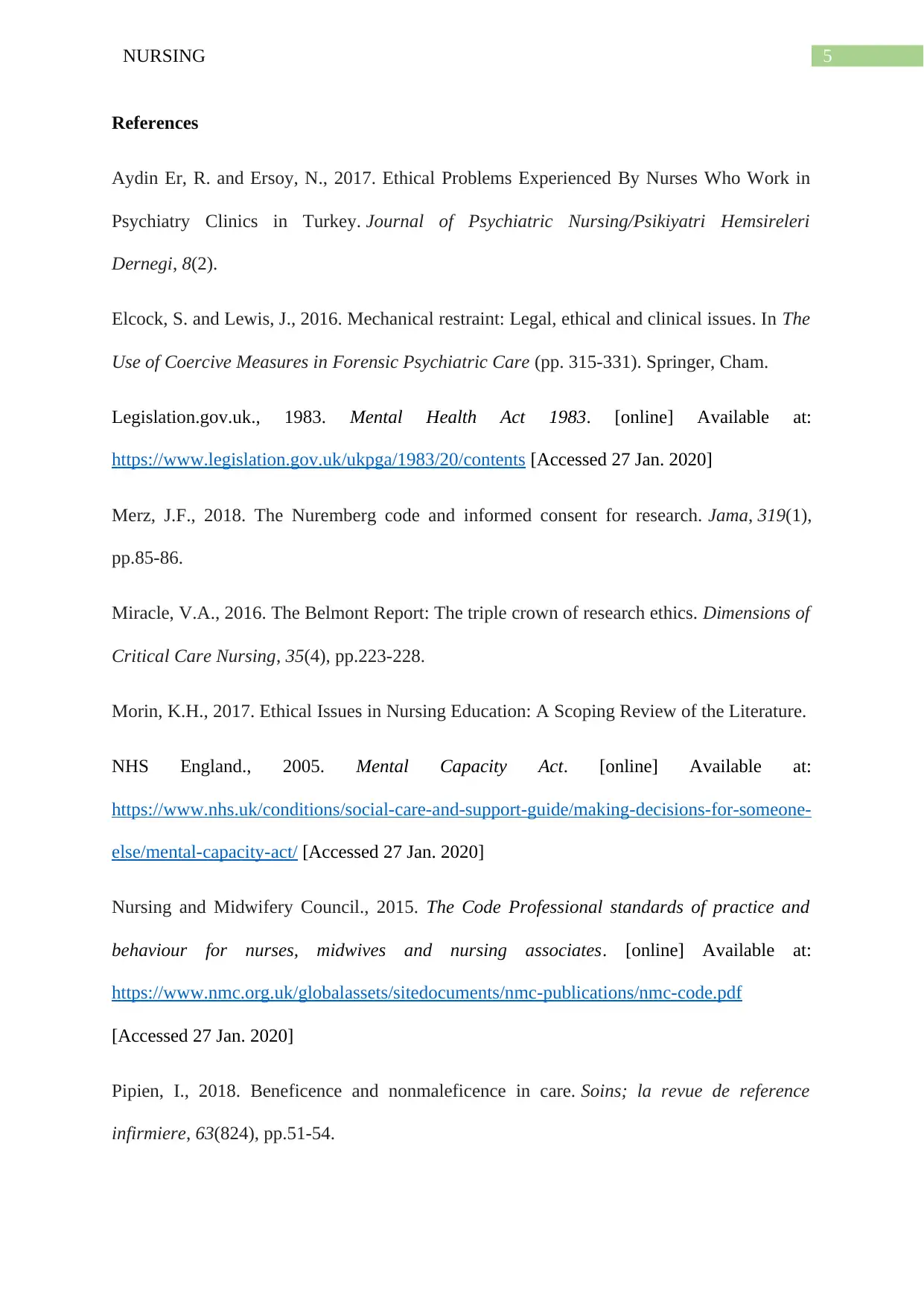
5NURSING
References
Aydin Er, R. and Ersoy, N., 2017. Ethical Problems Experienced By Nurses Who Work in
Psychiatry Clinics in Turkey. Journal of Psychiatric Nursing/Psikiyatri Hemsireleri
Dernegi, 8(2).
Elcock, S. and Lewis, J., 2016. Mechanical restraint: Legal, ethical and clinical issues. In The
Use of Coercive Measures in Forensic Psychiatric Care (pp. 315-331). Springer, Cham.
Legislation.gov.uk., 1983. Mental Health Act 1983. [online] Available at:
https://www.legislation.gov.uk/ukpga/1983/20/contents [Accessed 27 Jan. 2020]
Merz, J.F., 2018. The Nuremberg code and informed consent for research. Jama, 319(1),
pp.85-86.
Miracle, V.A., 2016. The Belmont Report: The triple crown of research ethics. Dimensions of
Critical Care Nursing, 35(4), pp.223-228.
Morin, K.H., 2017. Ethical Issues in Nursing Education: A Scoping Review of the Literature.
NHS England., 2005. Mental Capacity Act. [online] Available at:
https://www.nhs.uk/conditions/social-care-and-support-guide/making-decisions-for-someone-
else/mental-capacity-act/ [Accessed 27 Jan. 2020]
Nursing and Midwifery Council., 2015. The Code Professional standards of practice and
behaviour for nurses, midwives and nursing associates. [online] Available at:
https://www.nmc.org.uk/globalassets/sitedocuments/nmc-publications/nmc-code.pdf
[Accessed 27 Jan. 2020]
Pipien, I., 2018. Beneficence and nonmaleficence in care. Soins; la revue de reference
infirmiere, 63(824), pp.51-54.
References
Aydin Er, R. and Ersoy, N., 2017. Ethical Problems Experienced By Nurses Who Work in
Psychiatry Clinics in Turkey. Journal of Psychiatric Nursing/Psikiyatri Hemsireleri
Dernegi, 8(2).
Elcock, S. and Lewis, J., 2016. Mechanical restraint: Legal, ethical and clinical issues. In The
Use of Coercive Measures in Forensic Psychiatric Care (pp. 315-331). Springer, Cham.
Legislation.gov.uk., 1983. Mental Health Act 1983. [online] Available at:
https://www.legislation.gov.uk/ukpga/1983/20/contents [Accessed 27 Jan. 2020]
Merz, J.F., 2018. The Nuremberg code and informed consent for research. Jama, 319(1),
pp.85-86.
Miracle, V.A., 2016. The Belmont Report: The triple crown of research ethics. Dimensions of
Critical Care Nursing, 35(4), pp.223-228.
Morin, K.H., 2017. Ethical Issues in Nursing Education: A Scoping Review of the Literature.
NHS England., 2005. Mental Capacity Act. [online] Available at:
https://www.nhs.uk/conditions/social-care-and-support-guide/making-decisions-for-someone-
else/mental-capacity-act/ [Accessed 27 Jan. 2020]
Nursing and Midwifery Council., 2015. The Code Professional standards of practice and
behaviour for nurses, midwives and nursing associates. [online] Available at:
https://www.nmc.org.uk/globalassets/sitedocuments/nmc-publications/nmc-code.pdf
[Accessed 27 Jan. 2020]
Pipien, I., 2018. Beneficence and nonmaleficence in care. Soins; la revue de reference
infirmiere, 63(824), pp.51-54.
⊘ This is a preview!⊘
Do you want full access?
Subscribe today to unlock all pages.

Trusted by 1+ million students worldwide
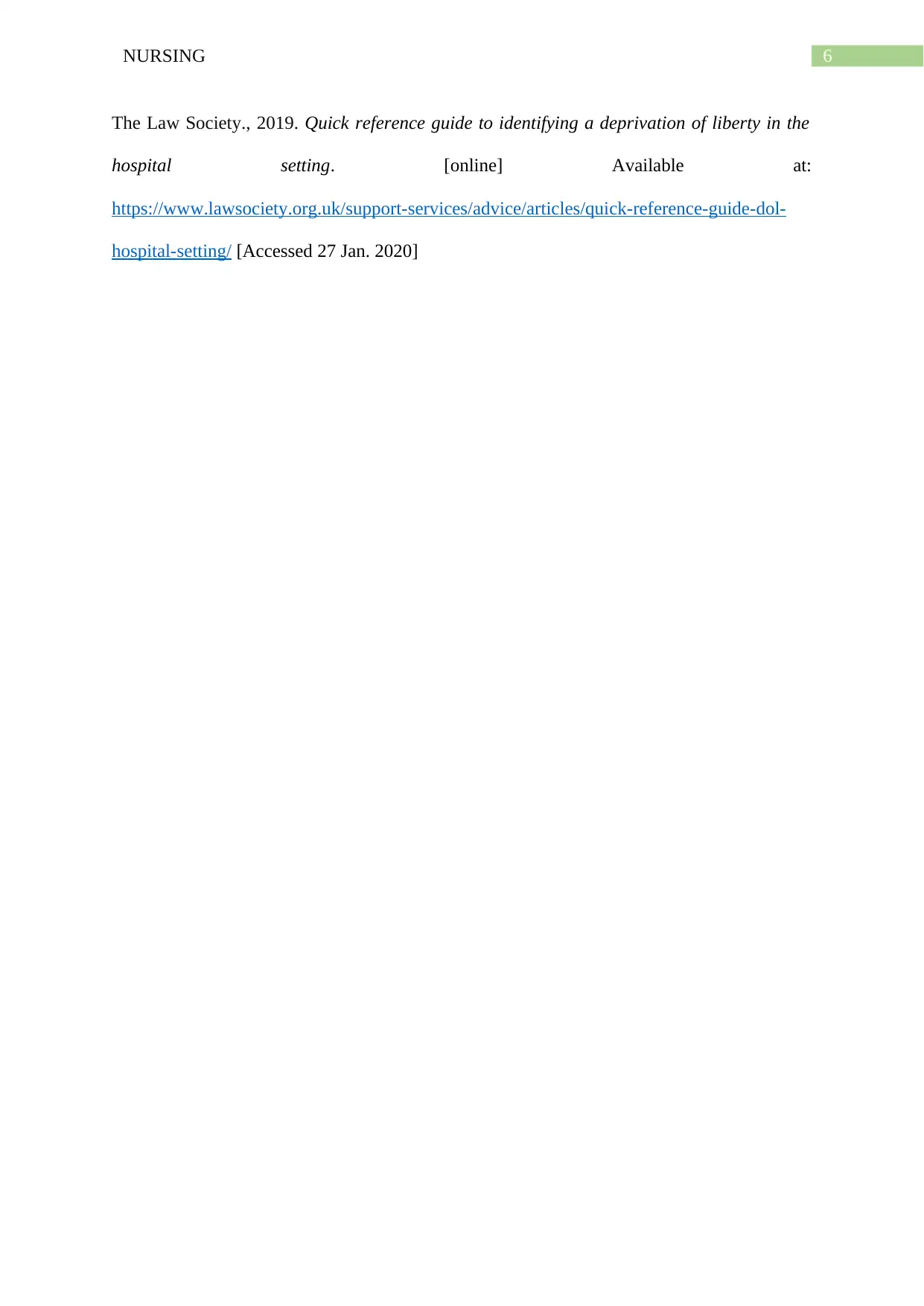
6NURSING
The Law Society., 2019. Quick reference guide to identifying a deprivation of liberty in the
hospital setting. [online] Available at:
https://www.lawsociety.org.uk/support-services/advice/articles/quick-reference-guide-dol-
hospital-setting/ [Accessed 27 Jan. 2020]
The Law Society., 2019. Quick reference guide to identifying a deprivation of liberty in the
hospital setting. [online] Available at:
https://www.lawsociety.org.uk/support-services/advice/articles/quick-reference-guide-dol-
hospital-setting/ [Accessed 27 Jan. 2020]
1 out of 7
Related Documents
Your All-in-One AI-Powered Toolkit for Academic Success.
+13062052269
info@desklib.com
Available 24*7 on WhatsApp / Email
![[object Object]](/_next/static/media/star-bottom.7253800d.svg)
Unlock your academic potential
Copyright © 2020–2025 A2Z Services. All Rights Reserved. Developed and managed by ZUCOL.





